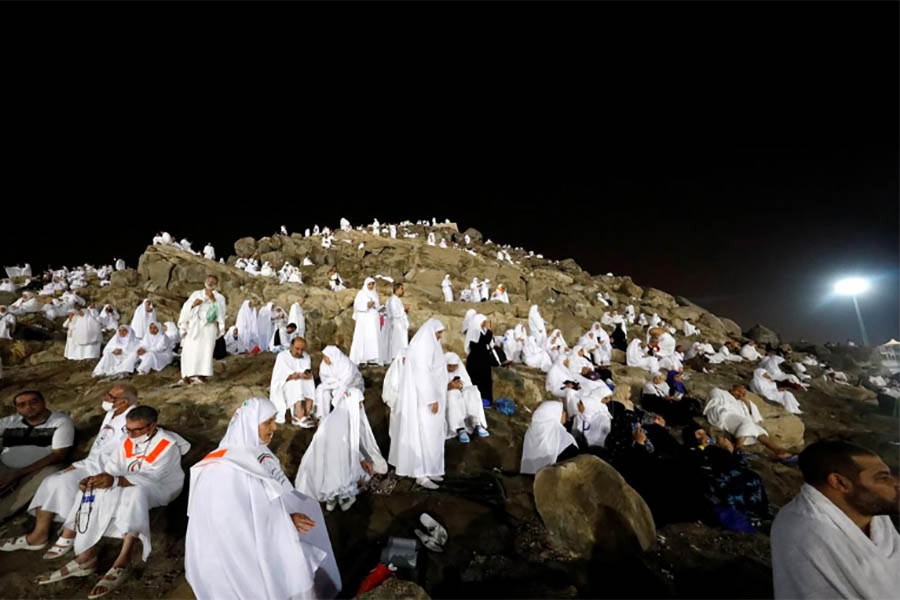More than two million hajj pilgrims gathered at Saudi Arabia’s Mount Arafat on Saturday amid the summer heat and regional tensions for a vigil to atone for their sins and seek forgiveness from the almighty Allah as part of the annual pilgrimage.
Pilgrims clad in white robes signifying a state of purity spent the night in a sprawling encampment around the hill where Islam holds that God tested Abraham’s faith by commanding him to sacrifice his son Ismail. It is also where Prophet Mohammad (SM) gave his last sermon.
Other worshippers who had been praying in the nearby Mina area ascended in buses or on foot from before dawn. Some carried food, carpets for camping and fans to keep cool as temperatures rose toward 40 degrees Celsius (104 degrees Fahrenheit).
Zaid Abdullah, a 30-year-old Yemeni who works in a supermarket in Saudi Arabia, said he was praying for his own country, where war has killed tens of thousands of people and caused the world’s worse humanitarian crisis, and for Muslims around the globe.
“We can tolerate the heat because our sins are greater than that,” he said as he approached the granite hill also known as the Mount of Mercy. “We ask God to alleviate the heat of the hereafter. As for the heat of this life, we can bear it.”
Taxi driver Khaled Maatouq said he was seeking an end to fighting in his native Libya: “I pray that God unites us.”
For others, the pilgrimage is a form of relief. Egyptian merchant Ramadan al-Jeedi said he was grateful to accompany his mother after his father died last year.
“It’s the greatest feeling, to feel that God the almighty chose us to be in this place,” he said.
Saudi Arabia has said more than two million pilgrims, mostly from abroad, have arrived for the five-day ritual, a religious duty once in a lifetime for every able-bodied Muslim who can afford the journey.
Among them are 200 survivors and relatives of victims of the attacks on two New Zealand mosques in March.
The pilgrims will spend the day on Mount Arafat. By sunset they will move to the rocky plain of Muzdalifa to gather pebbles to throw at stone columns symbolizing the devil at Jamarat on Sunday, which marks the first day of Eid al-Azha, or the feast of sacrifice.
IRAN TENSIONS
Saudi Arabia stakes its reputation on its guardianship of Islam’s holiest sites, Mecca and Medina, and organizing the pilgrimage.
A perennial concern is the potential for disease spreading among pilgrims, who spend five days in close quarters, often eating outside and sleeping on the ground near holy sites.
The world’s largest annual gathering of Muslims has in the past also seen stampedes, fires and riots, with authorities sometimes struggling to respond. Hundreds were killed in a crush in 2015, the worst disaster to strike hajj for at least 25 years.
Tensions are particularly high this year between Saudi Arabia, ruled by Sunni Muslims, and Shi’ite Muslim Iran.
The seizure of commercial vessels and attacks on tankers near the Strait of Hormuz, a narrow waterway separating the rival countries, have unsettled shipping lanes linking Middle Eastern oil producers to global markets.
The area has become the focus of a standoff between Tehran and Washington, which has beefed up its military presence in the Gulf since May.
Pilgrimage is also the backbone of a Saudi plan to expand tourism under a drive to diversify the kingdom’s economy away from oil. The hajj and year-round umrah generate billions of dollars in revenue from worshippers’ lodging, transport, fees and gifts.
Officials aim to increase the number of umrah and hajj pilgrims to 15 million and 5 million respectively by 2020 and the umrah number to 30 million by 2030.


